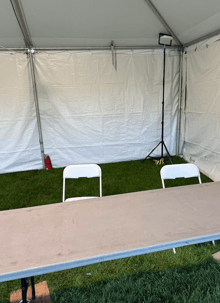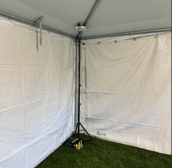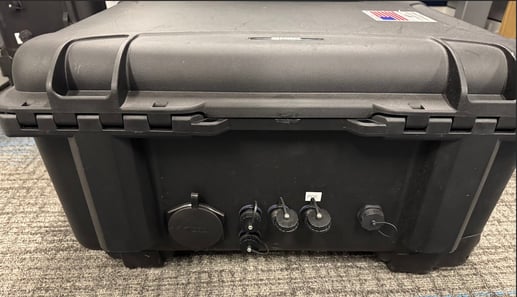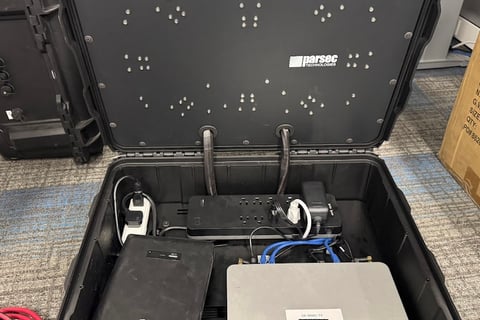Network in a Case
Needing a mobile network option? Here's what we came up with.
Trevor Krzesnik
11/2/20246 min read
There were many times we were asked to provide network for an event or come up with a way to provide network without the hassle of having wires everywhere like you would normally see in a IDF or MDF room. This led us to what we have deemed our 'network in a case'. On the outside, it looks just like a black storage box with a couple spots to plug in devices but open it up and what you can do with the case is pretty dang cool.
The case in use here is from Parsec Antennas and they offer many different versions to help you achieve the quality of signal you are looking for. Looking at the front of the case, you can see there are 4 ports available for you to plug in your devices if desired. Your power is just an extension cord plugged into the side of the case. The majority of cases offered are IP67 rated so they can withstand most instances of dust and water and it comes with a suitcase style handle to help you easily transport the case. Now let's get into the details of what we put together.
Our Build
Internet
The easiest way to provide internet in a mobile situation or a location where running cable isn't an option is to use cellular. The speeds offered by cellular providers, especially when using a 5G mobile network, can be very impressive. Depending on how good your signal is and whether you're on 4G/LTE or 5G, you can typically get above 200 Mbps download speeds. The most glaring counter to this is well you have to have great cell signal for that to even be an option. Being in a somewhat mountainous region, there are some cell providers that offer better service in more rural areas than many other of the major carriers can provide. Our major carriers in the area are Verizon, T-Mobile, and FirstNet (AT&T). To maximize the cell coverage options we have available, we installed a Cradlepoint with Dual SIM routers. The Cradlepoint device allows us to set a static primary/secondary, load balance between the two, or just let the Cradlepoint device decide which service provider is best and just run off that. From the Cradlepoint device, we have two ethernet cords from each router plugged into our next device.
Network
During COVID, there became a time when many employees who were not deemed as "essential" were granted the ability to work from home. Because of this, we needed to provide a solution for employees to access their work from home and while keeping everything secure. The solution that made the most sense, and is still in use today, is the Meraki security appliances. The MX68 was the best option at the time. It had eight wired ports for those who wanted to be wired into the Meraki, two Internet ports, and two PoE ports. This would allow those who used an IP desk phone to take it home with them. It also gave us the capability to broadcast our SSIDs so those who might not have an easy way to connect wired to the Meraki can connect to wireless.
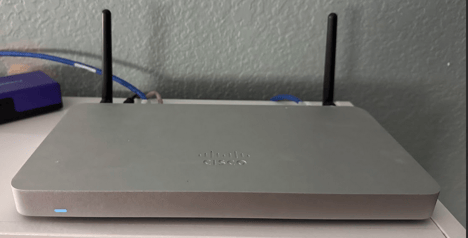

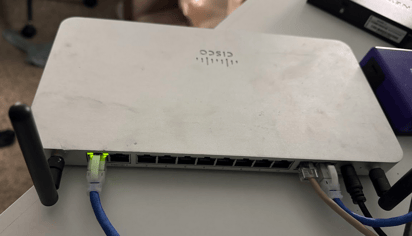

Front View
REAR View
This device will easily integrate into our network in case solution. With two Internet ports on the Meraki, we can now plug both of our cell service providers directly into to the MX68. The ports on the front of our antenna case give us options as to where we want to plug those in on the Meraki. We have the option to use standard wired ports with 802.1X, hybrid, or open. The other, and more appealing option, is to plug two of the front ports into our PoE ports and run APs off of our Meraki. This is where it gets a little tricky though. It is not impossible, but difficult for the end users, to run wireless off of the Meraki AND to have APs plugged into the Meraki. Devices struggle with roaming and just start to cause problems. I generally will turn wireless off on the Meraki if APs are being plugged in. At this point, how you use the combination of devices is up to you.
Battery
To help with small blips while installing or when running off of generators, a small UPS was installed inside the case to support about 10 minutes of downtime.
Use Cases
As I said earlier, with this network in a case, we are able to provide network for many different situations. I will share a some of our larger use cases.
Packet Pickup
For the last few years I have been tasked with providing wireless for a packet pickup event we have in one of our local parks. Obviously our standard option of a comm closet isn't going to be an option here. With 10-15 devices using simple data, we should have plenty of bandwidth to use our network in a case solution. The layout was going to be 4 somewhat large tents but wireless wasn't needed in all of them. I had generator power available so I placed the network case in the middle tent and then ran cable from the case to where I would setup my two APs. I had a 9130 setup on stands about 10 feet high on opposite ends of the tents. Luckily the farthest tent from the middle did not need wireless so I should easily be able to cover the area with two APs. I setup an SSID for them to connect to and they were ready to go. The event lasted for three days and the only issue we had was at the beginning when a spider box from the generator had a fuse trip.
Ambulance Wireless
We used a similar setup to our network in a case on our ambulances so we are able to provide network coverage for those assisting patients. Inside the ambulances, there are power plugs for us to plug in the two devices they need for connectivity. The Cradlepoint then has an antenna mounted to the top so its not trying to gather signal from inside the metal box ambulance. We have run into some issues when the ambulances are put on shore power and just the Meraki is left on. For some reason, it struggles to come online if it is turned on before the Cradlepoint is turned on.
Clinic Outage
We had a situation not too long ago where we had a squirrel chew through some fiber which took down one of our clinics. The quickest way to provide some sort of network for our staff was to bring our network in a case and place it as close to the patient rooms/physicians as possible so we are not completely impacting patient care and having to send people home. Some applications may struggle a bit running on this but, in general, it will suffice until we are able to get the fiber repaired.
Flu Clinics
Many times during flu season, we will do a brats and shots event where they will setup in a picnic area and provide lunch to those who want to come and get their flu shots for the season. The network in a case option makes it super easy to provide wireless coverage for those who are administering shots to patients/staff while keeping any sort of tripping hazards to a minimum. For this type of setup, we can generally just run wireless off of the Meraki but there have been some situations where we've had to run a directional AP off of the Meraki to provide coverage in parking lot areas.
Conclusion
As you can see, there are many options for how you can use a network in a case. I'm excited to see all the different use cases as the need for wireless continues to grow at a rapid rate. Do you have something similar? Share!
